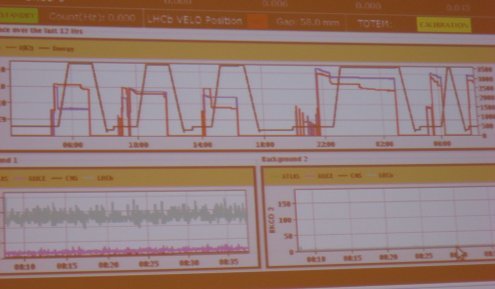
Crossing the thin black line
By James Dacey at CERN
This chart shows the first of two aborted attempts to collide two 3.5 TeV proton beams here at the Large Hadron Collider (LHC) at CERN.
Today is supposed to mark the beginning of the LHC physics programme, and the world’s press is gathered here at the particle physics laboratory to experience the events as they unfold.
Look closely at the chart and you will see the thin black line – which represents beam energy – plummet just after 6 this morning. This was done intentionally by beam engineers, who noticed that bunches of protons had become unstable, and it was better to “dump” the beams in a controlled manner rather than allow them to capitulate freely, which could damage equipment.
This process occurred again at around 8.45, following a similar fault.
I have been whizzing around the LHC’s experiments on the media bus to get the reaction of CERN scientists.
“You should not be at all surprised by this – there are many things that can go wrong with the beams, but the fundamentals have been set in place over the past few weeks,” said Crispin Williams, a detector scientist at ALICE.
Another scientist, Hans-Peter Beck, at the ATLAS experiment, explained to me the difficulties of trying to collide the two proton beams.
“It is like a set of marbles slipping down a sheet of ice. We know they will get to the bottom, but it is very difficult to predict or control their trajectories.”
The next attempt is expected to take place in around an hour’s time.
Watch the CERN webcast here.



